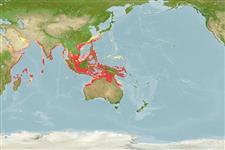Environment: milieu / climate zone / depth range / distribution range
ນິເວດວິທະຍາ
ສັດທະເລ ອາໄສຢູ່ໃກ້ໜ້າດິນໃຕ້ພື້ນທ້ອງນ້ຳ; ລະດັບຄວາມເລິກ 1 - 100 m (Ref. 9792), usually 20 - 50 m (Ref. 9792). Tropical; 26°N - 21°S, 43°E - 156°E (Ref. 54739)
Indo-West Pacific: Red Sea and East Africa to Japan and Australia.
Length at first maturity / ຂະໜາດ / ນ້ຳໜັກ / Age
Maturity: Lm 38.0, range 37 - 39 cm
Max length : 64.0 cm TL ຕົວຜູ້/ບໍ່ມີເພດ; (Ref. 6006); common length : 50.0 cm TL ຕົວຜູ້/ບໍ່ມີເພດ; (Ref. 5450); ນ້ຳໜັກສູງສຸດທີ່ເຄຍຈັດພີມມາ: 9.0 kg (Ref. 1468)
ຄີ (ໜາມ)ແຂງຢູ່ຫຼັງປາ (ທັງໝົດ): 9 - 11; ຄີຫຼັງຂອງປາ (ຄີອ່ອນ) (ທັງໝົດ): 38-45; ຄີ(ໜາມ) ແຂງຢູ່ຄີກົ້ນປາ
ກຸ່ມປາກະດູກແຂງ
ຄວາມຖີ່ຂອງກຸ່ມຖ່າຍທອດພັນ
ປາທີ່ມີການເຄື່ອນຍ້າຍຈາກທະເລໄປຫານ້ຳຈືດ ແລະນ້ຳຈືດຫາທະເລ
ປາທີ່ມີການເຄື່ອນຍ້າຍຈາກທະເລແລະໄປໄຂ່ຢູ່ນ້ຳຈືດ
ຄີກົ້ນຂອງປາ
ສັດທີ່ມີກະດູກສັນຫັຼງ
ການຖ່າຍທອດທາງກຳມະພັນຈາກພໍ່ແມ່ຫາລູກ 1; ຄີກົ້ນຂອງປາ: 33 - 43; ສັດທີ່ມີກະດູກສັນຫຼັງ: 23 - 25. Body oval and flat, but thicker than in most other flatfishes. Mouth large with strong teeth; maxillary extends well beyond hind edge of lower eye; both eyes on left or right side; upper eye lying immediately below dorsal edge; gill rakers not developed. Dorsal fin origin well posterior to eyes; anterior fin rays spinous; lateral line almost straight. Color usually brown or grey, sometimes with 4 broad, dark crossbars. Dorsal, anal and caudal fin tips black. Blind side occasionally partially colored. (Other sources of morphological data: Refs. 591, 529, 4416, 5997 and 6000).
Found on sand and mud bottoms (Ref. 9796, 48637). Usually deeply burried in the substrate during the day, but out and hunting at night (Ref. 48637). Often swims in an upright position (Ref. 9796). Mainly piscivorous (Ref. 5986). Mainly sold fresh (Ref. 5213); also utilized smoked and frozen (Ref. 9987). Processed into fish flour (Ref. 6040).
Studies in Porto Novo, India (Refs. 5993 & 5997) show that the sex ratio significantly differ from 1:1, but the reports are ambiguous as to which sex predominates.
Nielsen, J.G., 1984. Psettodidae. In W. Fischer and G. Bianchi (eds.) FAO species identification sheets for fishery purposes. Western Indian Ocean fishing area 51. Vol. 3. (Ref. 3485)
IUCN Red List Status (Ref. 130435)
Threat to humans
Harmless
Human uses
ການປະມົງ: ເປັນສີນຄ້າ
ຂໍ້ມູນຕື່ມອີກ
ເອກະສານອ້າງອີງການລ້ຽງສັດນ້ຳຂໍ້ມູນການລ້ຽງສັດນ້ຳສາຍພັນກຳມະພັນElectrophoresesການຖ່າຍທອດທາງກຳມະພັນຈາກພໍ່ແມ່ຫາລູກພະຍາດການປຸງແຕ່ງNutrientsMass conversion
ເຄື່ອງມື
Special reports
Download XML
ແຫຼ່ງອີນເຕີເນັດ
Estimates based on models
Preferred temperature (Ref.
123201): 26.6 - 29.1, mean 28.2 °C (based on 1198 cells).
Phylogenetic diversity index (Ref.
82804): PD
50 = 0.7500 [Uniqueness, from 0.5 = low to 2.0 = high].
Bayesian length-weight: a=0.00676 (0.00507 - 0.00901), b=3.14 (3.06 - 3.22), in cm total length, based on LWR estimates for this species (Ref.
93245).
ຊັ້ນເຂດຮ້ອນ (Ref.
69278): 4.4 ±0.3 se; based on diet studies.
ຄວາມຢືດຢຸ່ນ (Ref.
120179): ຂະໜາດກາງ, ປະຊາກອນຕຳ່ສຸດທີ່ໃຊ້ເວລາສອງເທົ່າ 1.4 - 4.4 ປີ (K=0.26-0.5; tm=3-4; Fec=300,000).
Prior r = 0.74, 95% CL = 0.49 - 1.11, Based on 3 stock assessments.
Fishing Vulnerability (Ref.
59153): Low to moderate vulnerability (29 of 100).
Climate Vulnerability (Ref.
125649): High to very high vulnerability (68 of 100).
Nutrients (Ref.
124155): Calcium = 122 [62, 249] mg/100g; Iron = 1.15 [0.54, 2.15] mg/100g; Protein = 18.4 [16.9, 19.9] %; Omega3 = 0.181 [0.080, 0.383] g/100g; Selenium = 68 [30, 151] μg/100g; VitaminA = 20.1 [6.2, 65.2] μg/100g; Zinc = 0.728 [0.470, 1.071] mg/100g (wet weight);
